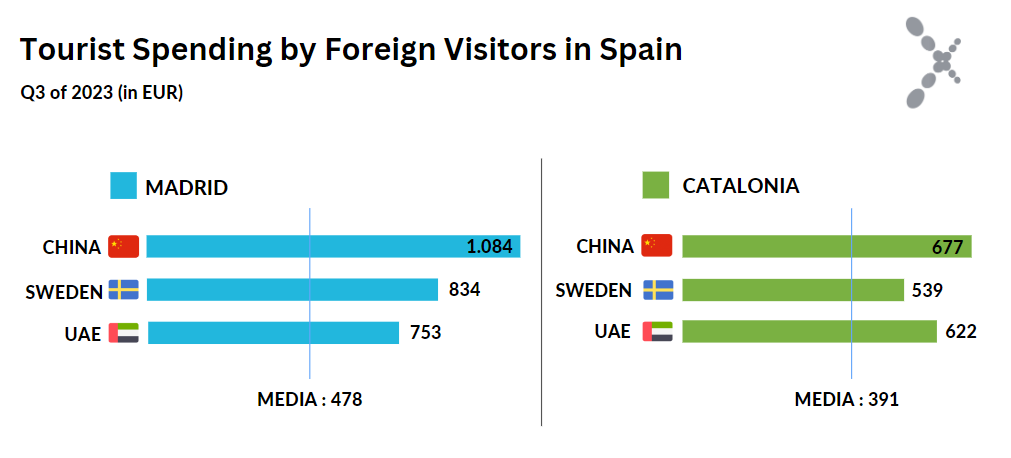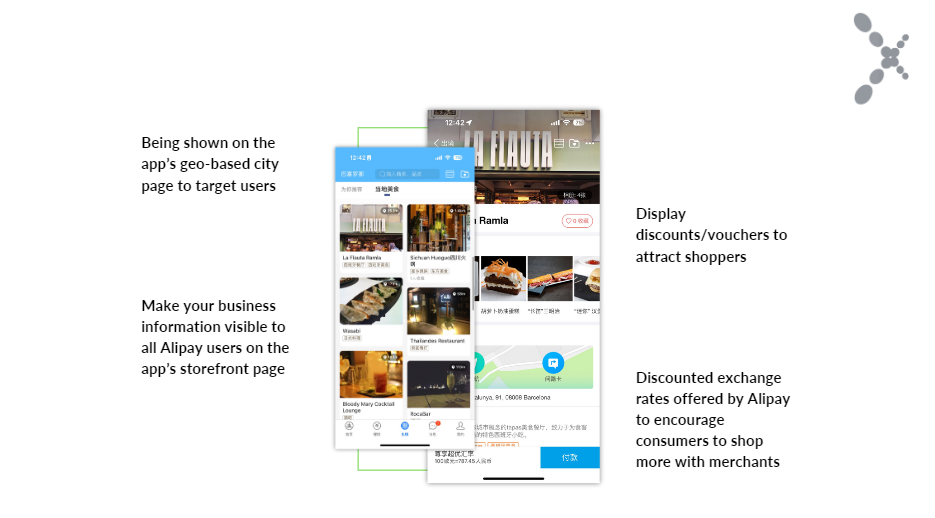Chinese tourists are gradually returning to Europe and the UK. According to the Spanish National Tourism Organization the number of Chinese tourists visiting Spain has increased by 420% in the first half of 2023, compared to the same period in the previous year. During the same period, Chinese tourists spending increased by 592%. This surge is attributed to the lifting of COVID-19 travel restrictions. During the third quarter of 2023, Chinese tourists spent the most money, €677 per capita. Moreover, during the summer of 2023, Chinese tourists were the highest spenders in Madrid, where they spent €1,084 per capita. Therefore, merchants in Spain and the rest of Europe shall take advantage of the return of Chinese tourists and launch targeted marketing campaigns to increase their visibility towards this audience and attract them to their establishments.

Merchants should note that Chinese tourists use social media to research and plan their trips before and during their travels. Once they arrive, they usually go straight to their chosen places for sightseeing, shopping, dining and other activities. Therefore, it is crucial for businesses to capture the attention of Chinese tourists before they arrive. This article explores how local restaurants can better target Chinese consumers by leveraging the characteristics of Chinese social media and combining them with your unique business model.
Integrate Chinese Payment Methods
China promotes “cashless” payment, whereas Alipay and WeChat Pay are the dominant ones. According to our 2023 survey of 1,200 Chinese consumers, 76.47% prefer using Alipay for payments while shopping abroad, and 66.15% are willing to use WeChat Pay. When merchants integrate Chinese payment methods into their checkout process, it improves their customers’ overall experience and increases the likelihood of Chinese tourists purchasing in their shop or restaurant.
Additionally, stickers saying “We support Chinese Payment” can make Chinese customers feel at home and increase foot traffic.
Utilise WeChat Ecosystem
WeChat, China’s most widely used super app, offers various channels to connect with consumers. These include the commonly used chat function (equivalent to WhatsApp), Official Accounts (similar to Facebook pages), and Mini-programs (sub-apps that are often used as in-app stores). Merchants can choose the best way to reach their target audience based on their budget and requirements.
Let’s take a local restaurant in Barcelona as an example:
- The restaurant can create a WeChat Official Account, sharing information about its culture, menu, seasonal dishes, events, etc. This can help increase the number of followers and improve the restaurant’s visibility in the Chinese market. As a result, it can attract more Chinese tourists to dine at the restaurant.
- Moments: This post feed is only accessible to WeChat users’ friends. Restaurants can use this feature to advertise and encourage users to forward articles or promotions to their circle of friends. This way, the marketing messages can reach a wider audience and attract more consumers.
- Mini-programs can be developed to take online reservations and order payment systems, among other things. These programs can help solve the main barrier that Chinese consumers face when travelling abroad: the language barrier. Customers can access the Chinese menu through the restaurant’s mini-program, quickly understand the dishes, and complete their orders online. Additionally, consumers can complete the payment without jumping to another app, realising “one-click order” and “one-click payment” within the program, significantly improving the user experience and order conversion rate.
Alipay City Page
Users accessing the Alipay city page will receive relevant push notifications based on geo-location. Since Google Maps is not accessible in China, users may not have the app downloaded. To address this, merchants can use the Storefront Page feature in Alipay to provide store information to Chinese tourists.
For example, when a visitor clicks on one of the local restaurants in Barcelona within the platform, he can access the restaurant’s business information on its Storefront page, along with highlighted dishes. Additionally, coupons can be displayed to attract customers.

XiaoHongShu- a prevalent platform to leverage
XiaoHongShu is a highly engaging social media platform in China, particularly popular among young people. It has gained importance among overseas merchants due to its focus on user-generated content and social sharing. More and more Chinese consumers are using XiaoHongShu to research and gather information about other users’ experiences before purchasing or travelling. Additionally, they often share their own experiences through posts, leading to a powerful “word-of-mouth” effect. XiaoHongShu’s algorithm effectively pushes relevant information to the intended audience, increasing communication efficiency. It leverages the user’s browsing history and interests to push information that aligns with their needs and interests, thereby ensuring that users receive information that is most relevant to them.

How to Use Chinese Social Media on the Customer Journey
So, let’s continue with the restaurant example:
Before the customers’ arrival
Establishing your presence on Chinese social media platforms effectively increases brand exposure and awareness among Chinese customers. Let’s say you already have a XiaoHongShu account and have been posting regularly. Collaborating with Key Opinion Leaders (KOLs) to create promotional campaigns for your restaurant can significantly enhance the results by generating buzz and attracting customers to include the restaurant in their dining list.
Upon the customers’ arrival at the destination city
Merchants can use the Alipay Storefront Page to drive online traffic to their physical stores. By utilising this page, users can conveniently access important business information about the merchant, such as their operating hours, addresses, and directions, all within the Alipay app. This feature provides great convenience to customers when they need to find information and directions.
Additionally, XiaoHongShu is a highly favoured app that travellers use to discover exciting destinations. To achieve better outcomes, it can be combined with offline activities. For the restaurant used as an example, merchants can organise tasting events, invite users to dine in the establishment and share their dining experience and feedback. This allows restaurants to receive valuable insights from Chinese customers. Moreover, participants’ sharing on social media also generates buzz and helps others with travel recommendations. For instance, a search for “Barcelona + food” would yield relevant posts and reviews of food destinations in Barcelona.
The platform also promotes the posts shared by users to more users. Moreover, based on the user’s location, relevant posts can be displayed to those already in Spain via the “Nearby” section of Xiaohongshu. This also includes people who are working, studying, or visiting Spain, which can drive more traffic to the recommended restaurant.
When the customers are at the restaurant
They will feel at home! The restaurant can post not only recommendations for specialities and seasonal dishes but also thoughtfully post bilingual menus on its Chinese social media account. Customers could easily refer to the Chinese menus in the post and order without struggling with the foreign language.
The restaurant could also enable Alipay+ and WeChat Pay so customers can pay directly in these apps in the merchant’s local currency using their preferred mobile payment method. The checkout is smooth and performed within seconds by scanning a payment QR code. The payment amount will be converted to RMB directly through Alipay+/WeChat Pay, while consumers will see the applied exchange rate on their phones. On the other hand, the restaurant receives settlements in the local currency (Euro) without worrying about currency conversion and its costs.
Alipay+ and WeChat Pay also sponsor seasonal promotions to support merchants in marketing and attract more store visits.
After customers leave the restaurant
After having a satisfying meal, numerous customers tend to share their dining experience on social media platforms during their outbound travel with their friends and family. As a result, they become brand advocates for the restaurant, attracting new customers and driving business growth.
In summary, for European and UK merchants, quality content marketing on Chinese social media is crucial to target Chinese tourists. The most popular platforms for this are WeChat, XiaoHongShu, Weibo, Douyin (Chinese TikTok), etc. Collaboration with KOLs, brand events, and other methods can further enhance marketing penetration, increase brand exposure and influence in the Chinese market, and gain a long-term competitive advantage.
Interested in learning about how to increase your visibility towards Chinese tourists? Get in touch with our experts!
PayXpert provides the product and services in all Europe and UK. The acquiring services are managed by PayXpert Spain for Europe and PayXpert Ltd for UK. More details about the products and services offered by PayXpert are accessible via their official websites in the UK (www.payxpert.co.uk) or Spain (www.payxpert.es)




